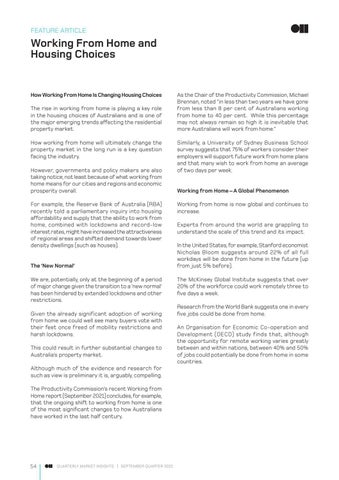FEATURE ARTICLE
Working From Home and Housing Choices
How Working From Home Is Changing Housing Choices The rise in working from home is playing a key role in the housing choices of Australians and is one of the major emerging trends affecting the residential property market. How working from home will ultimately change the property market in the long run is a key question facing the industry. However, governments and policy makers are also taking notice, not least because of what working from home means for our cities and regions and economic prosperity overall. For example, the Reserve Bank of Australia (RBA) recently told a parliamentary inquiry into housing affordability and supply that the ability to work from home, combined with lockdowns and record-low interest rates, might have increased the attractiveness of regional areas and shifted demand towards lower density dwellings (such as houses).
The ‘New Normal’ We are, potentially, only at the beginning of a period of major change given the transition to a ‘new normal’ has been hindered by extended lockdowns and other restrictions. Given the already significant adoption of working from home we could well see many buyers vote with their feet once freed of mobility restrictions and harsh lockdowns. This could result in further substantial changes to Australia’s property market. Although much of the evidence and research for such as view is preliminary it is, arguably, compelling. The Productivity Commission’s recent Working from Home report (September 2021) concludes, for example, that the ongoing shift to working from home is one of the most significant changes to how Australians have worked in the last half century.
54
QUARTERLY MARKET INSIGHTS
SEPTEMBER QUARTER 2021
As the Chair of the Productivity Commission, Michael Brennan, noted “in less than two years we have gone from less than 8 per cent of Australians working from home to 40 per cent. While this percentage may not always remain so high it is inevitable that more Australians will work from home.” Similarly, a University of Sydney Business School survey suggests that 75% of workers consider their employers will support future work from home plans and that many wish to work from home an average of two days per week.
Working from Home – A Global Phenomenon Working from home is now global and continues to increase. Experts from around the world are grappling to understand the scale of this trend and its impact. In the United States, for example, Stanford economist Nicholas Bloom suggests around 22% of all full workdays will be done from home in the future (up from just 5% before). The McKinsey Global Institute suggests that over 20% of the workforce could work remotely three to five days a week. Research from the World Bank suggests one in every five jobs could be done from home. An Organisation for Economic Co-operation and Development (OECD) study finds that, although the opportunity for remote working varies greatly between and within nations, between 40% and 50% of jobs could potentially be done from home in some countries.




